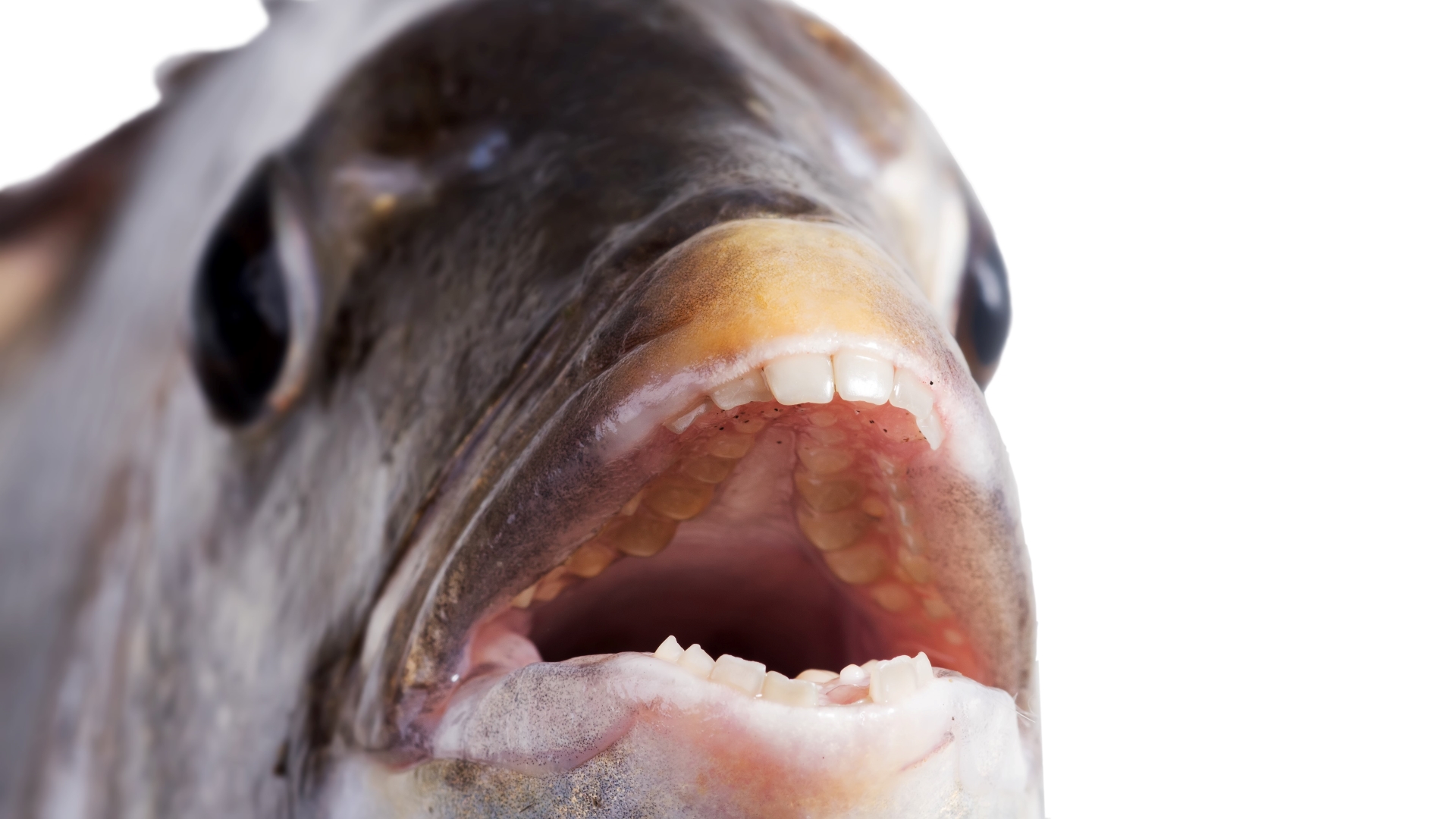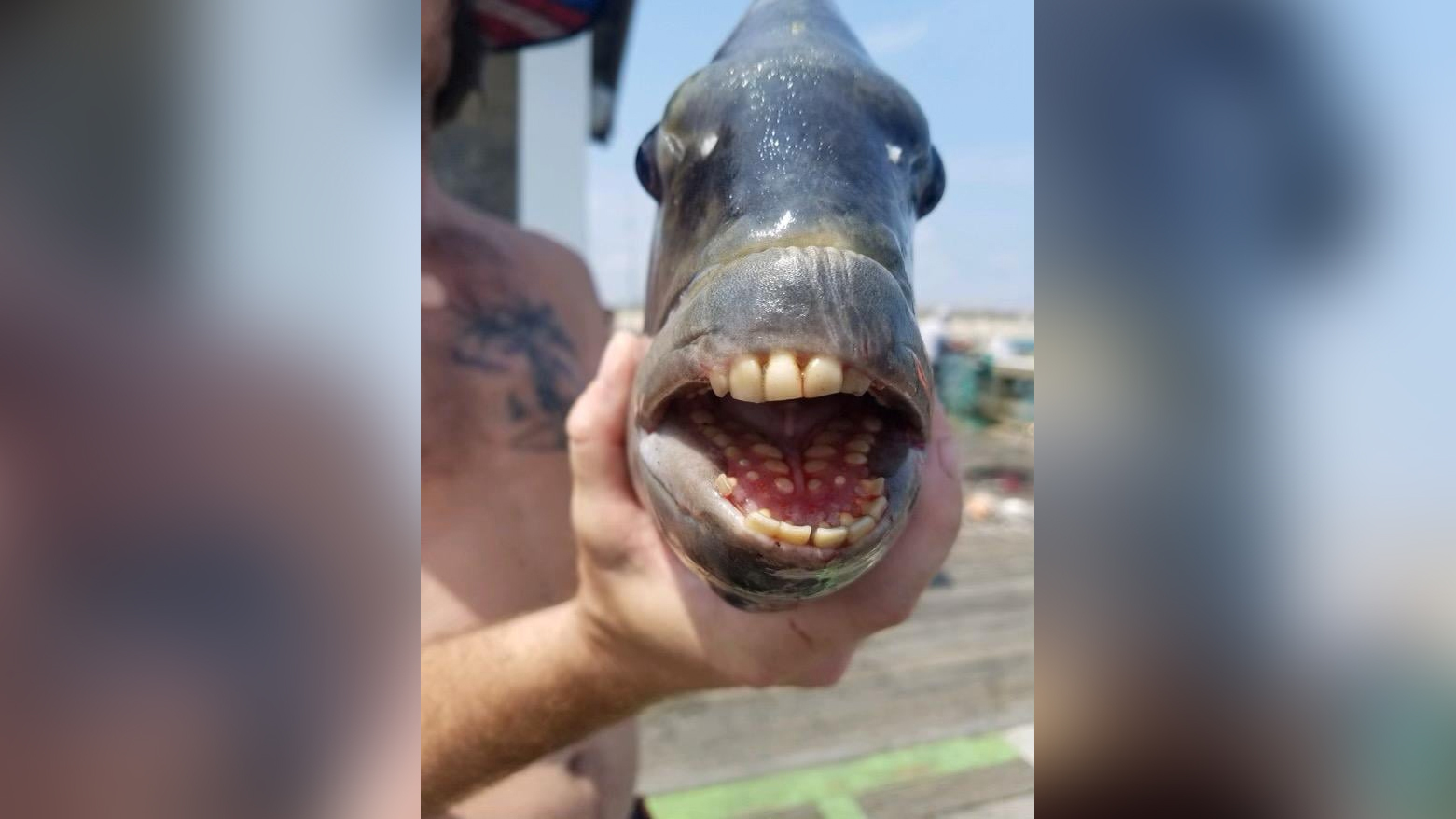Sheepshead fish: Facts about the fish with 'human' teeth
Sheepshead fish chew their food.

Sheepshead fish (Archosargus probatocephalus) are a species of ray-finned, predominantly marine fish commonly found along the eastern coastline of North America and South America. They are known for their front teeth, which can look uncannily like human teeth.
Sheepshead fish should not be confused with a similarly named species of fish on North America's western coastline called the California sheephead (Semicossyphus pulcher). While both fish species have teeth, they are not closely related and belong to different families.
What do sheepshead fish look like?
Sheepshead fish have dark vertical stripes running down their light gray bodies; the resemblance to striped prison jumpsuits inspired the nickname "convict fish," according to the Texas Parks and Wildlife Department. The fish also have sharp spines running down their backs. Most sheepshead fish grow to between 17 inches and 17.7 inches (43 to 45 centimeters) long. However, some individuals can reach up to 36 inches (91 cm long), according to the International Union for Conservation of Nature (IUCN).
Why do sheepshead fish have teeth?
Sheepshead fish grow squarish, human-like teeth as they mature so they can feed on hard-shelled prey. As juveniles, they eat any soft-bodied animals they can find and a variety of small, shelled animals, including crustaceans a few millimeters long such as ostracods. Once sheepshead fish grow longer than about 2 inches (5 cm), they start eating hard-shelled animals such as mollusks and barnacles, according to the IUCN.
In 2021, anglers at Jennette's Pier in Nags Head, North Carolina caught a sheepshead fish with a spectacular set of gnashers, Live Science previously reported. Photos of the fish show that this species can grow prominent, human-like front teeth, as well as rows of stubby molars in their lower jaws.
Where do sheepshead fish live?
Sheepshead fish live in marine habitats and estuaries in the western Atlantic Ocean, from Nova Scotia in eastern Canada, down the eastern U.S. and Central American coastline, and as far south as southern Brazil, according to the IUCN.
Kingdom: Animalia
Phylum: Chordata
Class: Teleostei
Order: Perciformes
Family: Sparidae
Genus and species: Archosargus probatocephalus
Source: ITIS
While sheepshead fish usually live in salt water and slightly salty brackish water, they are sometimes found in freshwater habitats in winter, when they seek out warmer waters where springs and rivers empty into the ocean. In late winter and early spring, sheepshead fish head offshore to spawn, according to the Florida Museum of Natural History (FMNH). Sheepshead fish swim from the surface down to a depth of 49 feet (15 meters), according to the Smithsonian Tropical Research Institute in Panama.
Get the world’s most fascinating discoveries delivered straight to your inbox.
Related: Under the sea: 50 breathtaking images from our oceans
How do sheepshead fish breed?
To reproduce, a female fish releases her eggs, which a male then fertilizes with sperm. Scientists don't know much about sheepshead fish spawning behavior, but females may produce between 1,100 eggs and 250,000 eggs, according to FMNH. Once fertilized, the eggs hatch after just 28 hours. Sheepshead fish usually reach maturity at 2 years old and can live for at least 20 years.
Are sheepshead fish dangerous to humans?
Sheepshead fish are safe for human consumption and are commercially and recreationally fished along the southeastern coast of the U.S. and in the Gulf of Mexico, according to the IUCN. Even when sheepshead fish have a full set of gnashers they are typically not dangerous to humans, but it's not a good idea to provoke them.
"I would not hesitate to swim in waters inhabited by these fish," David Catania, the collections manager for ichthyology at the California Academy of Sciences in San Francisco, told Snopes.com in 2021 after a TikTok video describing a sheepshead as a "demon fish" went viral.
"They pose no threat to humans unless harassed," Catania added. "Since they are good to eat, sheepshead are targeted by anglers, so the handling of one after capture creates the possibility of being bitten or poked by their sharp dorsal fin spines.”
Are sheepshead fish endangered?
Sheepshead fish are not endangered. The IUCN last assessed the species in 2011 and concluded it should be considered "Least Concern" — a conservation category for species that are at very low risk of extinction. The species has a wide distribution and is abundant in many parts of its range with sustainable populations.
The IUCN found that the number of these fish being caught annually in commercial and recreational catches had declined before 2011, but the organization attributed these declines to laws limiting and banning the use of certain nets that are harmful to fish, and that it was not a sign that sheepshead fish populations were decreasing.
Additional resources
To view a map of where sheepshead fish live and a diagram of how they interact with other species, check out the Encyclopedia of Life website. To see a sheepshead fish feeding on clams, watch this short YouTube video by Collier Sea Grant. For more information about the fish that live on the eastern coastline of North America, check out "Atlantic Coast Fishes of North America" (Houghton Mifflin Harcourt, 1999).
Originally published on Live Science.

Patrick Pester is the trending news writer at Live Science. His work has appeared on other science websites, such as BBC Science Focus and Scientific American. Patrick retrained as a journalist after spending his early career working in zoos and wildlife conservation. He was awarded the Master's Excellence Scholarship to study at Cardiff University where he completed a master's degree in international journalism. He also has a second master's degree in biodiversity, evolution and conservation in action from Middlesex University London. When he isn't writing news, Patrick investigates the sale of human remains.



